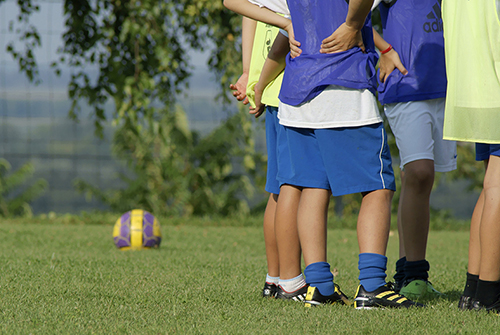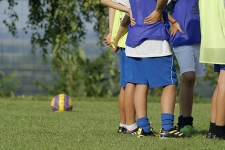
In recent years, there have been a multitude of other sports enter the mainstream options for young athletes. For instance, team sports like soccer and lacrosse are now just as common as baseball, football, and basketball. Children are also starting to join teams at younger ages, which means that training – some of which can be quite intensive depending upon the competitiveness and “select” nature of the team – begins earlier as well. And, while it may seem like your little basketball player is going to be the next Michael Jordan, it’s always good to remember that “specializing” in a sport – especially at a young age – can often times do more harm than good. This is due to the fact that kids who concentrate on a single sport at too young an age are much more likely to develop foot and ankle injuries (not to mention burnout) when compared to their more mature counterparts.
Sports Training
Because of the fact that every child matures – both physically and mentally – at his or her own rate, training that occurs early on should focus on proper technique, especially in children under the age of 10. It’s always important to keep in mind that there is no amount of training that can improve one’s natural athletic ability; however, training can most certainly improve technique and coordination.
It’s also important to teach children the importance of properly warming up. Learning to stretch (properly) at a young age sets the stage for years to come and can go a long way in helping to prevent injuries.
Shoes
Like it or not, shoes are a part of the sporting life. However, what’s “cool” might not be what’s best for the feet of your child – the build and condition of the shoe doesn’t necessarily like up with the price tag. Instead of buying one expensive pair of shoes (soccer, basketball, etc) it’s often recommended purchasing two pairs of less costly shoes may serve you better in the long run. With two pairs, the shoes can be rotated so as to avoid rapid deterioration. If you begin to notice excessive wear on the outsole or loss of support it’s time to buy new kicks.
Proper fit is also crucial – you can buy the best shoes in the world but, if they don’t fit right, they’re not going to do anyone much good. When trying on new shoes, make sure to allow for at least one finger’s width from the end of the longest toe. Due to the fact that kids feet are constantly growing you’ll want to make sure that that growth has somewhere to go. Also, have your child try on both shoes with whatever type of athletic sock they’ll be wearing, and make sure the laces are tight. If the shoes feel “right” after walking around the store for a bit, then that’s the one you’ll want to buy.
It’s important to note that a running shoe is NOT an all-purpose shoe and should not be treated as such. Lateral movement is much more difficult in a running shoe and can often times pose a greater risk of injury. All-purpose shoes tend to work well for children under the age of 10 or so; after that, sports specific shoes will be the next stop as they tend to provide a better degree of protection to the feet of your young athlete.
Growing, growing…growing
The bones are ligaments in children are different from their adult counterparts due to their immaturity and the fact that they’re still growing. Because their growth plates haven’t finished closing, they’re much more susceptible to injury than the tendons and ligaments that support the joints. Additionally, repetitive overuse can cause the growth plates to become inflamed – this is just one of the many reasons why physicians advise that children not specialize in a sport. In fact, statistics have shown that children who focus solely on one sport are actually setting themselves up for injury, which is why playing multiple sports is so beneficial – not only do you lower the likelihood of burnout but, because no two sports are played the same, you also limit the possibility of an overuse injury.
Common Injuries and Treatments
Lots of kids have a tendency to suffer from mild “torsional” imbalances – you might know this as “in-toeing” or “out-toeing”. Most children outgrow these imbalances without any type of medical intervention; however, they can increase the risk of injury and, therefore, should be monitored in regards to the susceptibility of foot and/or ankle injury.
Foot injuries that are commonly seen in children who are very active include:
Shin Splints – shin splints are caused by tiny tears or inflammation of the muscles in the anterior portion of the leg. Again, rest is an important component in the healing of this type of injury.
Sever’s Disease – This is an inflammation of the growth plate next to the heel bone, and is typically felt as pain behind the heel, where tendon is attached to bone. Rest and ice are the typical course of treatment for Sever’s Disease.
Sprains – in older kids, sprains (stretched or torn ligaments) of the ankle tend to be more common that fractures. Sprains can be quite painful and may cause an extensive amount of swelling around the joint – just like a fracture.
Fractures – Fractures due to overuse are common in children, with growth plates being especially prone to injury. If a break is relatively straightforward, rest and immobilization tend to be the best treatment, while more complicated fractures may require surgical intervention.
Regardless of how careful one may be, sometimes injuries are unavoidable – especially in the world of athletics. Dr. Krejci – Prairie Orthopaedic’s foot and ankle surgeon – is here to help! Specializing in all areas of the foot and ankle – including the sports medicine aspect – makes Dr. Krejci and her highly skilled team of nurses and physical therapists the perfect people to help get you back on your feet again!
source: aapsm.org

